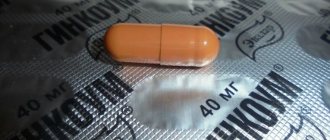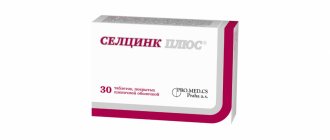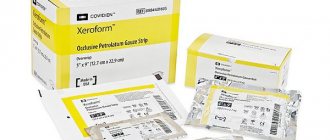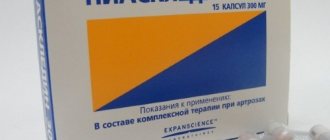| Composition and release form How the drug works When prescribed (indications) How to use (dosage) Contraindications for use Side effects of use | Overdose symptoms Drug interactions What to pay attention to Retinalamin analogs Prices in pharmacies Reviews from people who have used it |
Directions for use and dosage
Adult patients
To prepare the Retinalamin solution, the powder is dissolved in water for injection, 0.9% saline solution of sodium chloride or 0.5% solution of procaine (novocaine).
For the treatment of taperetinal abiotrophy, diabetic retinopathy, central retinal dystrophies, compensated open-angle glaucoma, Retinalamin solution is prescribed intramuscularly or parabulbarly in an amount of 5–10 mg once daily. The course of treatment can last 5 - 10 days, it can be repeated after 3 months or six months.
For myopic disease, Retinalamin solution is administered parabulbarly once daily at 5 mg for up to 10 days.
Children 1–5 years old
In the treatment of central retinal dystrophies and taperetinal abiotrophy, injections of the drug are prescribed parabulbarly or intramuscularly once, 2.5 mg daily.
Children 6–18 years old
In the treatment of central retinal dystrophies and taperetinal abiotrophy, parabulbar or intramuscular injections of the drug are prescribed daily, in a single dose of 2.5 or 5 mg. The course of treatment is up to 10 days, it can be repeated after 3 months or six months.
Composition and release form
The drug is available in the form of a powder (lyophilisate), which is used to prepare a drug solution for parabulbar or intramuscular administration. The color of this porous mass is white or with a slight yellowish tint. The total mass of the substance in each bottle is 22 mg.
One bottle contains:
- Retinalamin, which is a purified water-soluble polypeptide that is isolated from the retina of the eyeball of livestock, in an amount of 5 mg.
- Glycine, which is a stabilizer, in the amount of 17 mg.
Five bottles are placed in a package made of foil and PVC film. Next, two such packs are packed in a cardboard box along with paper instructions.
pharmachologic effect
Retinalamin contains a complex of polypeptide fractions, soluble in water, the molecular weight of which does not exceed 10 kDa.
It stimulates tissue separation and has a pronounced effect on the cellular elements of the retina and photoreceptors. The use of the drug helps improve the functional interaction between the outer segments of photoreceptors and the pigment epithelium, which are disrupted during degenerative processes. In addition, Retinalamin restores the normal permeability of the vascular wall, stimulates regeneration processes in case of injury or disease of the retina, and also accelerates the restoration of the sensitivity of the light receptors of the retina.
The mechanism of action of the drug is due to its metabolic activity. It improves metabolism in the cells of the eyeball, accelerates intracellular protein synthesis, restores the function of surface membranes, regulates the reaction of lipid peroxidation, thereby helping to normalize energy processes in the tissues of the eye.
Due to the fact that Retinalamin contains several different fractions of polypeptides, this drug is difficult to study for distribution in the body.
special instructions
It is important to know that the prepared single dose of medicine must be consumed in a timely manner and not stored in the refrigerator. Taking Retinalamin does not affect psychomotor reactions, so during the treatment period you can drive vehicles, engage in intellectual activity, and work associated with increased concentration.
- Eggplant baked in the oven with tomatoes and cheese: recipes with photos
- How to arrange links from the Internet in the list of references according to GOST in an abstract, coursework or dissertation
- Beef salad: delicious recipes
Price of the drug Retinalamin
The cost of the drug "Retinalamin" in Moscow pharmacies starts from 3,500 rubles.
In our ophthalmology center you can take courses of parabulbar (injections into the eyes) and intramuscular injections of the drug. The cost of a parabulbar injection is 700 rubles, an intramuscular injection is 300 rubles. (excluding the cost of the medicine).
In addition, all types of effective medical, physiotherapeutic and surgical treatment of retinal diseases are available at the Moscow Eye Clinic.
Contraindications
The use of Retinalamin is contraindicated for:
- individual intolerance and hypersensitivity;
- minors, since there is not enough data to confirm its effectiveness in primary compensated open-angle glaucoma, myopic disease or diabetic retinopathy;
- under the age of one year with taperetinal abiotrophy (peripheral or central) and with central retinal dystrophy caused by inflammation or injury;
- during pregnancy, since there are no results of studies of safety and effectiveness in this category of patients.
During treatment with the drug, breastfeeding should be stopped.
Retinalamin analogs
For abiotrophy, myopia and other eye diseases with a sharp decrease in vision, it is recommended to consult a specialist for individual advice at the first symptoms. If the use of Retinalamin causes side effects or does not improve visual acuity, the ophthalmologist introduces a replacement. Analogs of this medication are presented in the following list:
- Vidisik. This is an eye gel recommended for dry eye syndrome. You need to put 1 drop of the composition into each eye up to 35 times a day. Course – 5-10 days.
- Artelak Splash. Eye drops to moisturize, nourish and relieve symptoms of inflammation. The medicine should be used for 5-10 days, several times a day (1 drop per eye).
- Korneregel. An eye gel that needs to be placed into the conjunctiva. In 1 day, you are supposed to perform 3-5 procedures, to be treated until the unpleasant symptoms completely disappear and the visual fields expand.
- Okoferon. This is a medicinal liquid for the eyes, which must be instilled 2 drops every 2 hours. The course of treatment is up to 10 days.
- Systane. This is a rehydrant in the form of a sterile solution, which is instilled 1-2 drops into each eye until the alarming symptoms are completely eliminated.
- Ophtolic. According to the instructions for use, 1-2 drops should be dropped into each eye in turn, then blink thoroughly.
- Opt. It is a substitute for natural tears, especially important for dry eye syndrome. It is required to instill 1 drop for each eye up to 5 times a day for a week.
Retinalamine lyophilisate for the preparation of a solution for intramuscular and parabulbar administration 5 mg No. 10
Name
Retinalamin.
Release forms
Lyophilisate.
INN
Polypeptides of the retina of livestock eyes.
FTG
Tissue regeneration stimulator.
Compound
Each bottle contains: active substance - Retinalamin® 5 mg, (a complex of water-soluble polypeptide fractions isolated from the dry extract of Retinalamin®), excipient - glycine 17 mg (stabilizer).
Pharmacotherapeutic group
Other drugs used in ophthalmology. ATX code: S01ХА.
Description
Lyophilized powder or porous mass of white or white with a yellowish tint.
Pharmacological properties
Pharmacodynamics Retinalamin is a complex of water-soluble polypeptide fractions with a molecular weight of no more than 10,000 Da. The drug has a stimulating effect on photoreceptors and cellular elements of the retina, helps improve the functional interaction of the pigment epithelium and the outer segments of photoreceptors, glial cells during dystrophic changes, and accelerates the restoration of light sensitivity of the retina. Normalizes vascular permeability, reduces the manifestations of local inflammatory reaction, stimulates reparative processes in diseases and injuries of the retina. The mechanism of action of RETINALAMINA® is determined by its metabolic activity: the drug improves the metabolism of eye tissue and normalizes the functions of cell membranes, improves intracellular protein synthesis, regulates lipid peroxidation processes, and helps optimize energy processes. Pharmacokinetics The composition of RETINALAMINA®, the active substance of which is a complex of polypeptide fractions, does not allow for conventional pharmacokinetic analysis of its individual components.
Indications for use
Compensated primary open-angle glaucoma, diabetic retinopathy, central retinal dystrophy of inflammatory and traumatic origin, central retinal dystrophy, myopic disease (as part of complex therapy), central and peripheral taperetinal abiotrophy.
Directions for use and dosage
For adults, 5-10 mg 1 time per day is dissolved parabulbarly or intramuscularly in 1-2 ml of 0.5% solution of procaine (novocaine), water for injection or 0.9% sodium chloride solution, directing the needle to the wall of the bottle to avoid foaming. The course of treatment is 5-10 days; if necessary, repeat after 3-6 months. For myopic disease: dissolve the contents of the 5 mg bottle in 1 ml of water for injection. Administer 0.5 ml (2.5 mg) parabulbarly into both eyes once a day. The course of treatment is 10 days. Recommended in combination with vitamins B6 and B12, pentoxifylline.
Side effect
Disturbances at the injection site: in very rare cases (less than 0.01% or 1:10,000) with parabulbar administration of the drug, reactions at the injection site may occur, which may have the following clinical manifestations: pain at the injection site, hyperemia (redness) at the injection site injections, swelling at the injection site. Immune system disorders: in very rare cases (less than 0.01% or 1:10,000), hypersensitivity reactions or allergic reactions may occur, which may have the following clinical manifestations: anaphylaxis reactions (anaphylactic shock, angioedema of the larynx). If any of the side effects indicated in the instructions get worse, or you notice any other side effects not listed in the instructions, tell your doctor.
Contraindications
Individual hypersensitivity to the components of the drug, pregnancy, breastfeeding.
Overdose
No cases of drug overdose have been reported.
Precautionary measures
Use RETINALAMINE® only as prescribed by your doctor! When using a 0.5% solution of procaine (novocaine) as a solvent for the drug RETINALAMINE®, you should adhere to the information on contraindications, precautions and age restrictions set out in the instructions for use of procaine (novocaine). The bottle with the dissolved medicinal product must not be stored or used after storage. RETINALAMINE® solution is not recommended to be mixed with other solutions. If an injection is missed, it is not recommended to administer a double dose, but to administer the next injection as usual on the scheduled day.
Use in children
There is no sufficient experience of use in children. Contraindicated for use in children under 18 years of age with compensated primary open-angle glaucoma, diabetic retinopathy, myopic disease (due to the lack of data on effectiveness and safety). Contraindicated for use in children under 1 year of age with central retinal dystrophy of inflammatory and traumatic origin, central and peripheral taperetinal abiotrophy. Use in children over 1 year of age with central retinal dystrophy of inflammatory and traumatic origin, central and peripheral taperetinal abiotrophy is possible only as prescribed by a doctor, if the expected therapeutic effect exceeds the risk of side effects: for children aged 1-5 years, parabulbar or intramuscular 2.5 mg 1 time per day, for children aged 6-18 years parabulbar or intramuscular 2.5-5 mg 1 time per day. The course of treatment is 10 days.
Use during pregnancy and breastfeeding
The drug is contraindicated during pregnancy (due to the lack of clinical trial data). If it is necessary to prescribe the drug during lactation, breastfeeding should be stopped (due to the lack of clinical trial data).
The effect of the drug on the ability to drive vehicles and machinery
In the case of parabulbar injections of the drug and an accompanying vision examination, temporary visual impairment is possible, affecting the performance of potentially hazardous activities that require special attention and quick reactions (driving vehicles, working with moving mechanisms).
Interaction with other drugs
No drug interactions have been described. Indication, if necessary, of the peculiarities of the action of the medicinal product upon first administration or upon its cancellation. There are no peculiarities of the action of the medicinal product upon first administration or upon its abolition.
Storage conditions
In a place protected from light at a temperature not exceeding 25 °C. Keep out of the reach of children.
Best before date
3 years. Do not use after the expiration date indicated on the package.
Vacation conditions
By doctor's prescription.
Package
Lyophilisate for preparing a solution for intramuscular and parabulbar administration, 5 mg. Produced in flint glass bottles in accordance with ISO 8362-1: 2009 with a capacity of 5 ml, sealed with rubber medical stoppers in accordance with GOST R ISO 8871-5-2010 or in accordance with ISO 8362-5:2008 with rolled-in aluminum caps with a tear-off purple plastic lining in accordance with GOST R 51314-99, or according to ISO 8362-6:2010, or according to ISO 8362-7:2006. 5 bottles each in a blister pack made of polyvinyl chloride or polyethylene terephthalate film and aluminum foil. 2 blister packs per cardboard pack along with instructions for use.
Buy Retinalamin liof.d/prig.solution for IM and s/w injection.5mg in bottle in pack No. 10 in the pharmacy
Price for Retinalamin lyof.d/preg.solution for IM and P/W injection.5mg in flask in pack No. 10
Instructions for use for Retinalamin lyof.d/prig.solution for i.m. and p/w injection.5mg in vial in pack No. 10
Parabulbar injections
When prescribing a course of parabulbar injections with Retinolamine, they are performed by a specialist with sufficient experience in such procedures in a specially equipped clinic room or in a sterile operating room. Injections of the drug do not require special preparations.
To obtain an injection solution, the leophilisate of the drug is diluted using an isotonic solution or procaine (0.5%) and water for injection. Administration is carried out with a disposable syringe with a slightly blunted needle. During the procedure, the needle enters percutaneously into the lower eyelid (outer edge) and advances approximately 1 cm in depth. The required dose of the drug is injected into the space at the back wall of the eyeball.
Retinolamine solution cannot be stored, therefore, after the injection, its remains are disposed of.
Drug interactions
Competent experts strongly do not recommend mixing several solutions in one bottle at once. As a result of such manipulations, the desired therapeutic effect of the drug is significantly weakened, and side effects cannot be ruled out. Otherwise, drug interactions with Retinalamin have not been recorded in practice and are not reflected in the detailed instructions.









